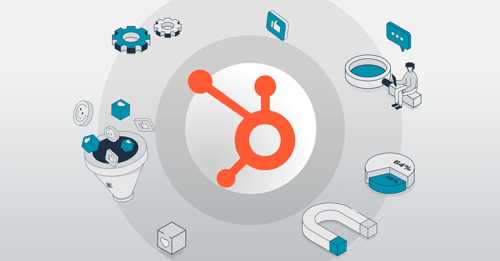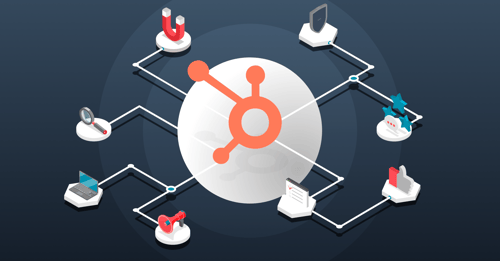First 100 days:
How to succeed in your new marketing job
OK, so you’re about to start your new Inbound Marketing Manager job – congratulations. You have a few years’ experience and your new company has a marketing automation platform like HubSpot set up.
But even though you’ve been there, done it and got the t-shirt – the first three months of your new job are crucial, and you need a high-impact strategy to get some quick wins.
In this blog post, we’ll share a straightforward, three-month framework which B2B Inbound Marketing Managers can follow to achieve success.
MONTH ONE
WEEK ONE
Work out who your audience are and build buyer personas
Before you begin your Inbound activities, define your buyer personas. These buyer personas are semi-fictional projections of your ‘ideal’ customer, based on real data you have accumulated, and are absolutely key to Inbound Marketing success. They help you to understand your customers’ problems, pain points and business objectives, allowing you to more effectively market your services and solutions to them.
How do you get a good understanding of your buyer personas? Get close to them. Meet with them and speak to them, but also speak to the people closest to them. For example, your sales team and customer service team field questions from potential customers and actual customers on a daily basis and will have some really good insight for you.
Think about the buyer’s journey
The buyer’s journey is essentially three stages through which your potential prospects go before enlisting your services or choosing your solutions. The stages are: Awareness, Consideration and Decision. In the Awareness stage, buyers are experiencing a problem and are trying to understand what it is. In the Consideration stage, they have clearly defined the problem and are looking for solutions. In the Decision stage, buyers know exactly what options are available and are trying to weigh up the most suitable solution or supplier. With these stages in mind, think about how you might create content at different stages of the buyer’s journey to educate, inform and inspire.
WEEK TWO
Goal setting
Now that you’ve constructed buyer personas, you need to run a goal setting workshop.
Before any kind of activity, you need to agree on the overall goals and specific objectives of your campaigns. This means running a goal-setting workshop to understand:
1) Current performance (website traffic, conversions, leads, new business opportunities, revenue generated)
2) Current conversion rates (how many visits does it take to generate one new piece of business
3) What the next goal for the business is and how it will be achieved
To start with, take a look at your existing data – website traffic, leads generated, new business opportunities – and work out what you want to achieve over the next three months.
Once you know what you want to achieve over the next three months, you need to work out how much more you need to reach that goal (whether it’s more website visits, leads or business opportunities) and how you’re going to do it.
For example, you might find that a lot of your website traffic, leads and new business opportunities come from paid advertising activity. You can then agree on a new goal/milestone for the next three months and develop a new paid advertising campaign to meet those goals, focusing on the channels that your target audience frequents.
Lead management workshop
Next, you need to think about your lead qualification and management process. A clear qualification process will make it easier for your marketing department to assess leads and ensure the hand off to sales is smooth and in line with the business’ requirements.
Leads passed over to sales must undergo, at the very least, a basic level of lead qualification to make sure that they are in fact interested in the business’ services and solutions. Bringing your marketing and sales teams together to decide on lead stage definitions and handover is vital.
With the above considered, a detailed lead management workshop should be done as soon as possible. Invite both marketing and sales to sit down and map out and document the lead management process – this should include every individual step a website visitor takes before becoming an actual paying customer. Each individual step should have a set of criteria that needs to be met before a lead is moved onto it. For example, moving a website visitor to a lead requires that the website visitor fill in and submit a form on a website – but what about moving from lead to marketing qualified lead (MQL)?
We would suggest that you use a form of lead scoring and assign points to leads based on actions they take on your website. For example, a lead becomes an MQL after filling out a certain number of forms for middle or bottom-of-the-funnel content assets.
Finally, each team should know the stages they are responsible for and when the handover occurs. Once the process has been documented, you should build it out in HubSpot using workflows to automate the transition of leads from one stage to the next. This will save you a lot of time – but more on that later.
WEEKS THREE & FOUR
Content auditing & planning
Content is the main variable when it comes to Inbound Marketing success. Not creating enough high-quality content means you may struggle to resonate and connect with potential customers of yours. Creating frequent, entertaining, high educational content will help you to attract people to your website, generate leads, win new customers and keep those customers year on year.
Use this time to see what content the business has already – and determine its value. With this in mind, you can conduct a content audit. This sounds tricky, but all you have to do is place each piece of content on a table that looks at buyer personas and buyer journey stage, like the one below.
|
|
Awareness |
Consideration |
Decision |
|
Buyer Persona 1 |
|
|
|
|
Buyer Persona 2 |
|
|
|
|
Buyer Persona 3 |
|
|
|
Completing this will enable you to identify content gaps in the business, develop a plan for new content assets and their distribution, and align your content marketing with your buyer personas.
Keyword research
You need to make it easy for searchers to find your business online and for Google to understand your website. We would recommend implementing a topic cluster model as part of your content plan.
This means you will have to create a pillar page (which provides a lot of information about a specific topic, e.g. 2,500 words) and surrounding it with sub topic content in the form of blog posts that go into more detail about a particular aspect of the topic in question.
For example, you could create a long-form web page entitled: “How to implement new HR software”, and then create 20-30 blogs on the challenges involved with the implementation. By doing this and linking all the content together, Google will start to see that page as an authoritative source of information.
Over time, your sub topics will generate more and more organic traffic and increase in ranking on search engine results pages. As your pages are all linked, the value is shared equally among the rest of the topic cluster - including the pillar page.
Build a content plan
It’s important to plan ahead. It’s all well and good saying how much content you’re going to create over the next three months but without a plan, how will you hold yourself accountable and how will you review your progress?
Start by creating a blog plan. It doesn’t matter if it’s in an Excel spreadsheet or a Word document – just as long as you have it and use it. In it you should have details of all the blogs you are looking to create on a weekly basis, along with keywords, internal links to other content and target buyer personas for each blog (this will ensure that the content you create resonates with the right people).
As well as a blog plan, you should have a downloadable content plan. This should include eBooks, case studies, white papers, infographics and any other downloadable content assets you need to create to support your marketing activity.
You should also think about creating a video content plan. Video is by far the most effective content format and if you’re not using video in your marketing activity, you’re missing out on opportunities to engage with website visitors. The video you create need not be complicated or long – think about what blogs you could repurpose or create videos alongside and embed them into your website.
Finally, decide on who will be creating the content. If you have a small marketing team you might need to enlist the help of external freelance writers. Where possible, however, you should lean on the expertise of your colleagues and get them blogging at least once or twice a month if they are stretched.
MONTH TWO
Promotional activity
Now you have established your buyer personas, decided on your keyword strategy and started to create high-quality content, you need to identify which channels you would like to use to engage with your audience and use to amplify your business’ content assets and messaging.
Social platforms such as Twitter, LinkedIn, Facebook and Instagram offer an excellent way to expand your Inbound Marketing activities and reach more interested parties. All of these platforms offer paid media services, allowing your to target really specific audiences, based on things like location, job titles and even specific companies.
In addition, as part of your role you will probably inherit a database of contacts that you will want to target. It’s important you build criteria-based lists and contact filters in order to understand the size and quality of that database. This will help you understand whether you need to focus on increasing the size of the database you have, which means providing easy conversions that drive lots of new contacts – or on the flip side you might want to focus your effort on a very specific part of that database that has a huge potential value.
Look at constructing an email marketing programme to target your most valuable leads. Ensure you segment your lists, personalise your emails and use action-orientated language and subject lines to get recipients to click through.
Website review
After developing and optimising your content assets, you need to host them on your website, through landing pages and ‘gate’ them behind submission forms. This means that website visitors need to provide their details to download the content, allowing you to generate leads that are interested in what you offer. Then you need to include thank you pages, which provide additional information and content to help move them further into the buyer’s journey.
However, this is just one stage of reviewing a website. You need to get a really good understanding of what pages people are landing on, and how they are progressing through your website. Do you have a really high drop off after the home page, or is there a specific page of your site that converts higher than others?
Once you understand this, you can manage your call-to-actions across your website that are key in encouraging website visitors to engage further with your business and potentially convert.
Remember that call-to-actions can come in a variety of different formats. From simple buttons and images, through to chat bots, live chat and ‘book a consultation’ meeting links – you should try to use a variety of these across your site into order to convert visitors.
MONTH THREE
Website edits
Now that you’re at a point where you have buyer personas, goals, keyword research and a content strategy – you need to think about the design and function of your website.
Your website has the potential to be your best marketer and salesperson, but only if it is equipped with the right tools and assets.
How your website looks and feels is incredibly important. In the past, it was all about static, brochure-type design: putting as much information on the page as possible and infinite scrolling.
Nowadays, websites take the approach of “less is more”, utilising white space, prominent CTAs, consistent branding, strong colours, easy navigation, responsive design and authentic (not stock) photos. Your website should have all of these elements in place at a minimum – and most importantly, it should be optimised for search engines.
Optimising your website for search engines means using the keywords identified earlier in month two to help searchers find your website.
Make sure you think about all the above before editing your website. Once you’ve done the design and technical elements, you need to think about what content you want to host on your website and how you want to drive visitors to it.
For example, your homepage is a great place to promote your best and most accessible content assets – i.e. those most likely to engage and convert website visitors into leads. Typically businesses have a mixture of video, case studies and service assets on their homepage – this gives them the best opportunity to connect with visitors at different stages of the buyer journey.
Lead management updates
If you have been following the guide thus far, you’ll have mapped out your lead management process for implementation into HubSpot (or any other tool).
The lead management process you build into HubSpot (or any other tool) should be based off the lead management workshop you completed in the first month. This might mean overhauling what’s already been set up to make way for the new processes. It’ll be troublesome to begin with but once you (and everyone else in the business) see the results of the new framework, you’ll love it.
Reporting and review
Lastly, reporting and review. How will you demonstrate the ROI of your marketing and sales activities? At this point, you need to work together with your department to agree on a reporting process, the metrics and KPIs (Key Performance Indicators) that the campaigns will focus on, and insert the goals that were set in month one into the reporting.
Make sure to document the reporting process and, if possible, save a custom filter in the analytics software you are using, as this will enable anyone in the business to pull the information they need, as and when they need to.
This concludes your first 100 days as an Inbound Marketing Manager. Did you make it?
The steps outlined above form part of our tried-and-tested approach to Inbound Marketing, one that continues to deliver incredible results for us and our clients. If you're looking for support with your next marketing campaign, learn more about Huble's marketing services, or get in touch with our team.












